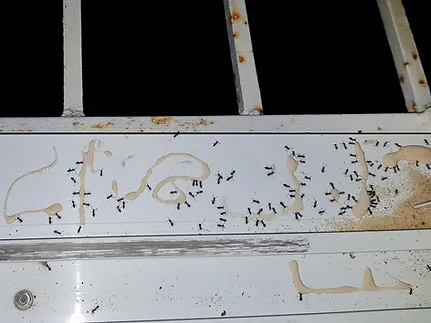Odorous House Ant Exterminator Treatment
Odorous house ants have the scientific name Tapinoma Sessile. They are small dark brown or black colored ant species which are called by other names such as stink ant, sugar ant and coconut ant.
Knowing about these pests can eventually help with finding solutions to exterminate them. Our seasoned ant exterminator treatments can help prevent ants from making their way in and eradicate them from your house altogether.
They are commonly considered stinky or odorous because when they get crushed, they give off an offensive rotten coconut smell.
This coconut like smell might be because of their preference for sugary sources of food like sweet food leftovers when indoors. Outdoors, they consume living and dead insects, pet food, liquid excrement, small dead animals and honeydew from aphids.
They are small in size, measuring only 1/16 up to 1/18 of an inch or 2.4 to 3.3 mm in length.
They can live sustainably both indoors and outdoors, in a myriad set of conditions. Odorous house ants tend and manage extremely huge colonies with several thousand workers. They don’t build their nests near soil mounds and they nest spontaneously anywhere. When nesting outdoors, they build in spaces that provide moisture and also blockage from the heat of the sun.
They are annoying pests when they enter buildings or homes searching for water, food or nesting sites. Their increased indoor presence can be associated often with the occurrence of rain outdoors.

They might be tiny but they are fast. They consistently travel in lines, but if you cause them reason to be alarmed or disturbed, they will run around and break up their line.
They don’t sting because they lack a stinging feature, but will bite you if you stick your hand into their nests and insist on disturbing their colonies.
If you want to avoid attracting odorous house ants into your premises, be guided by the following:
1. Correctly identify the ant species because odorous house ants require different treatment than other ants.
2. Eliminate conducive conditions which make them thrive. Determine what food leftovers you need to throw right away so that there will be no reason for them to be lured into your property.
3. If you see odorous house ants in spite of your efforts to remove food that attract them, place baits indoors and outdoors in areas where you locate them. Also, treat nests especially when they are small in number.
4. Pay special attention when placing the bait and treatment to perimeter areas, entry points and areas where the odorous house ants converge. Examples of these areas, are the ground sides of the walls and edges of doors, windows and vents.
If you are still experiencing problems with removing odorous house ants from your home, contact the pest control experts at Sniper Pest Control!
Learn more here
Click here to learn How an Ant Colony Operates
Have Queries?
Pest Control Fort Worth – Best in the Business
Request a Quote Today
Reach Us
Location :
1060 Cotton Depot Ln #642,
Fort Worth, TX 76102
